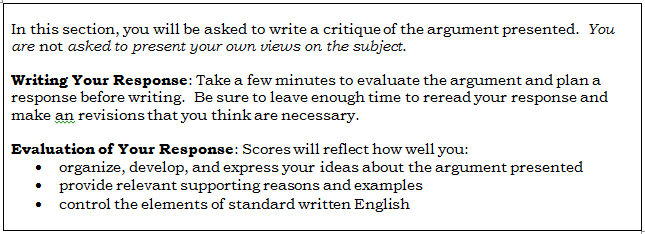
So just how important are the AWA scores for business school admissions? We certainly could argue that the GMAT Analytical Writing score is not so important. It’s undeniable that the Quantitative sections and Verbal sections, which contribute to the overall GMAT score, are considerably more important than the separate GMAT writing score. Arguably, the fact that the AWA section was “cut in half” when IR was added in 2012 is a further indication of the relative importance of the GMAT essay and its score.
- Recognize Unstated Assumptions: Recognizing assumptions is essential for the Critical Reasoning questions, and it will also serve you well on attacking the prompt argument in your AWA.
- Know the Directions: This a matter not only of knowing what they say but also, more importantly, understanding the various options you have for analyzing the argument. This list of analytical strategies is always given in the paragraph that follows the prompt argument. It’s important to get familiar with this “analytical toolbox”, so it is yours to employ on test day.
- Recognize the Common Flaw Patterns: GMAT AWA prompt arguments often contain one of six types of flaws. Learn to spot these patterns, so you are ready on test day.
- Plan Before You Write: This is obvious to some test-takers. Your first task is to find objections to and flaws in the prompt argument. Create a list of flaws. Then, select the 2-4 of those that are most relevant, that would be the most persuasive talking points. Once you have your list of insightful flaws, then you are ready to write.
- Use a Template: Many test takers find it helpful to have the basic structure of the AWA essay already planned out and practiced, so it’s just a matter of plugging in the specific details on test day. Here’s an example of a possible GMAT writing template. Feel free to adapt this template as is, modify it, or create one of your own.
- Paragraph #1: State that the prompt argument is flawed. Briefly enumerate the flaws you will examine, in the order that you will discuss them.
- Paragraph #2 (or #2 & #3): Sticking to that same order, analyze each flaw in detail, explaining your reasoning why each is a serious weakness of the argument.
- Last Paragraph: Suggest improvements, which are the reverse of the flaws (i.e. “This argument would be considerably stronger if it did such-and-such to remove flaw #2.”). Close by restating that is it a weak argument.
- Write with Variety: First of all, vary your sentence structures. Here are some examples of different structures:
- Simple sentence, one independent clause: Jack went to town.
- Sentence with two independent clauses: Jill went to town and Jack stayed home. (Two independent clauses can be joined by “and”, “or”, “but”, “yet”, “so”, etc.)
- Sentence with an independent clause and one (or more) dependent clauses: Jack went to the town where Jill lives.
- Sentence with an infinitive phrase: Jack went to that town to see Jill.
- Sentence with a participial phrase: Hoping to see Jack, Jill went to town.
It’s true that Business school adcoms rely on the Quant, Verbal and Composite scores significantly more than the GMAT writing score. In fact, recent evidence suggest that adcoms also rely on the IR score significantly more than the GMAT essay score.
You will not need any special knowledge outside of your own life experience and your general sense of the business world.
How to Score Your Practice GMAT Essays

A GMAT analytical writing sample essay, whether well done or flawed in itself, can help you polish your own GMAT writing and bring your essays to the next level. The important part of reviewing example GMAT essays is in analyzing them (and expert analysis is even more helpful, particularly at the beginning).
On your GMAT writing assignment, the test will present an argument, often in the context of a newspaper editorial or the statement of a company. The nature of this argument will generally allow you to argue for either side, and the side you choose does not affect your score. You will have 30 minutes to read the prompt and construct your essay. Later, your essay will be graded by both a computer and a person on a scale of 0 to 6
Yup, the rumors are true: you’ll encounter a 30-minute GMAT analytical writing section on test day. But while analytical writing can seem tough at first, finding out exactly what’s expected and how to attack it for a maximum score will do a lot to make the GMAT essay feel manageable! In this post, we’ll take a look at what you need to know to master the GMAT AWA.
The following paragraph always appears after the argument prompt. This is the real meat-and-potatoes of the AWA directions:

- “This plan is likely to fail due to flaws in the reasoning and logic of the editorial.”
- “This remedy is unlikely to be successful due to flaws in reasoning.”
- “This argument contains some egregious flaws in reasoning making the conclusion doubtful.”
- “The success of this recommendation is doubtful considering the logical flaws and faulty assumptions on which it is based.”
“Last year the parents of first graders in our school district expressed satisfaction with the reading skills their children developed but complained strongly about their children’s math skills. To remedy this serious problem and improve our district’s elementary education, everyone in the teacher-training program at Waymarsh University should be required to take more courses in mathematics.”
The following appeared as part of an editorial in the Waymarsh city newspaper:
Let’s try to make these suggestions more tangible. I have pulled an argument from the list of arguments that could appear on the test. All argument prompts for the AWA are made available so this is the perfect place to practice.
Only Two Things to Do

In the introduction, you really have only two tasks—summarize the argument and state that the argument is weak. You always want to paraphrase and summarize the argument—never copy it word for word. This will help you to synthesize the argument and understand it. And you can even limit this summary to the conclusion. You’ll end up discussing the premises in your body paragraphs when you talk about weaknesses so no need to worry about them in the introduction.
The GMAT Essay, also called the GMAT Analytical Writing Assessment, or AWA, requires you to read a short argument and make a written analysis of the argument. This opening GMAT task has a 30 minute time limit. How to crack the GMAT Analytical Writing section? Well, to start out, write a good introduction, and the rest of the essay will flow very naturally.
The editorial that appeared in the Waymarsh city Newspaper pointed out that parents were upset about their children’s math skills. To correct this issue, the editorial recommends that students in the teacher-training program at Waymarsh University take more courses in mathematics. This remedy is unlikely to be successful due to flaws in reasoning.

“For the past century, an increase in the number of residential building permits issued per month in a particular region has been a reliable indicator of coming improvements to that region’s economy. If the monthly number of residential building permits issued rises consistently for a few months, the local unemployment rate almost always falls and economic production increases. This well-established connection reveals an effective method by which a regional government can end a local economic downturn: relax regulations governing all construction so that many more building permits can be issued.”
“During a recent trial period in which government inspections at selected meat-processing plants were more frequent, the number of bacteria in samples of processed chicken decreased by 50 percent on average from the previous year’s level. If the government were to institute more frequent inspections, the incidence of stomach and intestinal infections throughout the country could thus be cut in half. In the meantime, consumers of Excel Meats should be safe from infection because Excel’s main processing plant has shown more improvement in eliminating bacterial contamination than any other plant cited in the government report.”
25. The following appeared in a memorandum from the publisher to the staff of The Clarion, a large metropolitan newspaper:
“The country of Oleum can best solve the problem of its balance of trade deficit by further increasing the tax on its major import, crude oil. After Oleum increased the tax on imported crude oil four months ago, consumption of gasoline declined by 20 percent. Therefore, by imposing a second and significantly higher tax increase next year, Oleum will dramatically decrease its balance of trade deficit.”
GMAT Essay practice question 1

“Of all the cities in their region, Beaumont and Fletcher are showing the fastest growth in the number of new businesses. Therefore, Avia should establish a commuter route between them as a means of countering recent losses on its main passenger routes. And to make the commuter route more profitable from the outset, Avia should offer a 1/3 discount on tickets purchased within two days of the flight. Unlike tickets bought earlier, discount tickets will be nonrefundable, and so gain from their sale will be greater.”
5. The following appeared in an announcement issued by the publisher of The Mercury, a weekly newspaper:
“Over the past two years, Pageturner’s profits have decreased by 5 percent, even though we have added a popular café as well as a music section selling CDs and tapes. At the same time, we have experienced an increase in the theft of merchandise. We should, therefore, follow the example of Thoreau Books, which increased its profits after putting copies of its most frequently stolen books on a high shelf behind the payment counter. By doing likewise with copies of the titles that our staff reported stolen last year, we too can increase profitability.”

The following paragraph always appears after the argument prompt. This is the real meat-and-potatoes of the AWA directions:
Finally, recommend a way to achieve the goal stated in the article. It is important to approach the analysis of the argument as an interested party. You don’t want to be wholly negative. For one, you will write a better analysis if you imagine yourself tied to the argument in some way, and two, the prompt asks you to strengthen the argument. Find some general evidence that will make the argument more convincing or make it irrefutable. Suggest a change so that the logic stands on firmer ground.
Yup, the rumors are true: you’ll encounter a 30-minute GMAT analytical writing section on test day. But while analytical writing can seem tough at first, finding out exactly what’s expected and how to attack it for a maximum score will do a lot to make the GMAT essay feel manageable! In this post, we’ll take a look at what you need to know to master the GMAT AWA.
- What are the assumptions of the argument, and how strong are they?
- What sort of facts would strengthen or weaken the argument?
- Are there alternative explanations or perspectives that would explain the facts in question better?
How to Approach the GMAT AWA

By the time you sit down on test day, you should have read the directions to the AWA (they’re posted above—take another look!), so you won’t need to waste time reading them again. Instead, dive straight into AWA brainstorming. As you brainstorm, list the argument’s flaws
Devoting 30% or more of your available study time to AWA is likely unwise, but devoting 0% to AWA might also hurt you. Between those, erring on the low side would be appropriate. If, in a three-month span, you write half a dozen practice essays, and get generally positive feedback on them with respect to the GMAT standards, that should be plenty of preparation.
While you don’t need to write like Herman Melville, you need to be competent. A GMAT Analytic Writing score below 4 may cause business schools to question your competence. That’s why it’s important to have at least a decent showing in AWA.

You will not need any special knowledge outside of your own life experience and your general sense of the business world.
- Identification: Focus on a Premise: The first thing you will need to do in your paragraph is to identify what part of the argument you intend to analyze. The best way to do this is by simply summarizing the premise in the argument. You can state that it is flawed at this point, but it is not necessary. You’ll have plenty of time to do that, and the reader already knows what will happen from what you told them in the introduction. Paraphrase, summarize, and use synonyms to present the premise—don’t copy word for word—and this is a great way to lay the groundwork for your analysis.
- Name Calling: Describe the Flaw: Now that you have summarized the premise and presented it to the reader, time to name the flaw and describe it. You might not always able to name the flaw in the argument and are not required to know the name of logical fallacies, but do it if you can. This is a great way to signal to the reader that you know what is going on in the arguments, and it will focus your mind on how to expose the flaw. Argument flaws are flawed for different reasons and each requires a certain approach when analyzing and attacking. Here is a fun, engaging resource that goes through some common, everyday logical flallacies, which you are bound to see some of on the test.
Once you know what to expect from GMAT analytical writing, it’s time to start implementing strategies that will help you maximize your score on this section. Keep coming back to these throughout your GMAT prep to ensure that you’re staying on track and pushing your GMAT writing to the next level!
By the time you sit down on test day, you should have read the directions to the AWA (they’re posted above—take another look!), so you won’t need to waste time reading them again. Instead, dive straight into AWA brainstorming. As you brainstorm, list the argument’s flaws
Introduction to GMAT Analytical Writing

Those AWA tips are all important to keep in mind for your GMAT writing. But when you actually sit down at the computer on test day, what should you do? Here’s the process to use to get the most out of your 30 minutes with the GMAT AWA!
But while it’s true that, in your GMAT preparation, Quant and Verbal and even IR deserve more attention than the AWA, it’s also true you can’t completely neglect AWA. The difference between a 5 or 6 as your GMAT Analytic Writing score will not make or break a business school admission decision, but having an essay score below a 4 could hurt you.
On your GMAT writing assignment, the test will present an argument, often in the context of a newspaper editorial or the statement of a company. The nature of this argument will generally allow you to argue for either side, and the side you choose does not affect your score. You will have 30 minutes to read the prompt and construct your essay. Later, your essay will be graded by both a computer and a person on a scale of 0 to 6
